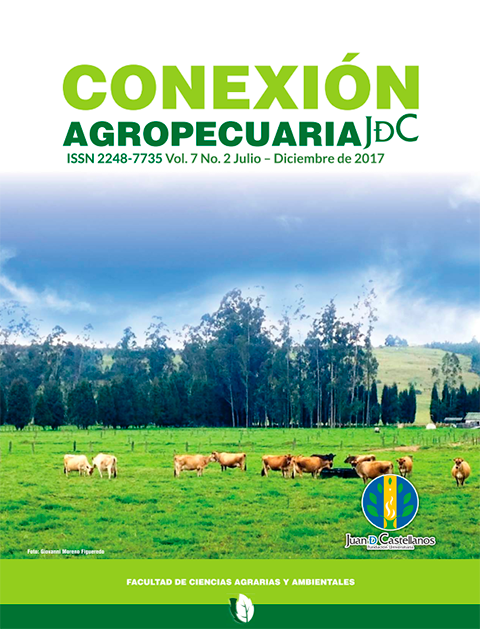Keywords:
fog collector, fog, rural solidarity, PRA, water harvestAbstract
This work shows a socio-environmental experience obtained with 15 dispersed rural young participants from the municipality of Sucre, they received training with participatory methodology and training in the use of a natural resource such as water from fog. With the participative methodology, the young participants improved aspects such as communication, respect, solidarity, tolerance, and commitment, they understood the importance of the role of rural women and were able to install 2 collectors or fog catchers of 2 m2 for each one. The young people collected daily data of precipitation and fog, both for wet and dry days. They determined quantities, frequencies, variations, and accumulations of these events with the help of a small meteorological station. The work period was from May 1st to November 25th, 2016, and the accumulated collection data for fog catchers in the dry season (from May to July) were 70 liters or equal to 17.5 liters per square meter.Downloads
Download data is not yet available.
References
ALCALDÍA MUNICIPAL DE SUCRE SANTANDER. Recuperado de http://<www.sucre-santander.gov.co>.
BROOKS, D. (2002). Agua. Manejo a nivel local. Ottawa, Canadá: Ed. Alfaomega/ Centro Internacional de investigaciones para el desarrollo.
CERECEDA, P., HERNÁNDEZ, P., LEIVA, J., y RIVERA, J. (2014). Agua de niebla. Nuevas tecnologías para el desarrollo sustentable en zonas áridas y semiáridas. Coquimbo, Chile: Pontificia Universidad Católica de Chile.
GODÍNEZ, T. (2013). Recolección de agua por rocío y niebla. (Tesis). Universidad Nacional Autónoma de México, México.
LOCALIZACIÓN DEL CORREGIMIENTO DE LA GRANJA-SUCRE. Recuperado de http://<www.google.com/maps/lagranja>.
MENDOZA, B., y CASTAÑEDA, F. (2014). Criterios metodológicos para la definición de sistemas de captación de aguas con base en lluvia horizontal. (Trabajo de Especialización). Universidad Católica de Colombia, Bogotá, Colombia. Recuperado de https://repository.ucatolica.edu.co/bitstream/10983/1748/1/Atrapanieblas%20B.%20Mendoza%20F.%20Casta%C3%B1eda.pdf.
PARDO, R. (2017). Diagnóstico de la juventud rural en Colombia. Grupos de dialogo rural, una estrategia de incidencia. Serie documento N° 227. Grupo de Trabajo: Inclusión Social y Desarrollo. Santiago, Chile: Rimisp.
QUEZADA, M. (2009). Diseño generativo aplicado en sistemas de atrapanieblas en el norte de Chile. (Tesis Grado). Universidad de Chile, Santiago de Chile, Chile. Recuperado de https://webcache.googleusercontent.com/search?q=cache:Yka-XMWNMgkJ:https://www.u-cursos.cl/fau/2010/1/DIT-503/1/material_docente/bajar%3Fid_material%3D453794+&cd=1&hl=es-419&ct=clnk&gl=co.
SORIANO, M. (2015). Niebla como fuente alternativa para suministro de agua. (Trabajo de Especialización). Escuela Colombiana de Ingeniería Julio Garavito, Bogotá, Colombia. Recuperado de https://repositorio.escuelaing.edu.co/bitstream/001/243/1/Soriano%20Mateus-%20Manuel%20Antonio-2015.pdf.
UNESCO. (2011). Cátedra UNESCO. Revista Internacional de Sostenibilidad, Tecnología y Humanismo, (7), 51-56.
YÁÑEZ, M., y ACEVEDO, K. (2013). El acceso al agua para consumo humano en Colombia. Revista de economía institucional., XV(29), 125-148.
BROOKS, D. (2002). Agua. Manejo a nivel local. Ottawa, Canadá: Ed. Alfaomega/ Centro Internacional de investigaciones para el desarrollo.
CERECEDA, P., HERNÁNDEZ, P., LEIVA, J., y RIVERA, J. (2014). Agua de niebla. Nuevas tecnologías para el desarrollo sustentable en zonas áridas y semiáridas. Coquimbo, Chile: Pontificia Universidad Católica de Chile.
GODÍNEZ, T. (2013). Recolección de agua por rocío y niebla. (Tesis). Universidad Nacional Autónoma de México, México.
LOCALIZACIÓN DEL CORREGIMIENTO DE LA GRANJA-SUCRE. Recuperado de http://<www.google.com/maps/lagranja>.
MENDOZA, B., y CASTAÑEDA, F. (2014). Criterios metodológicos para la definición de sistemas de captación de aguas con base en lluvia horizontal. (Trabajo de Especialización). Universidad Católica de Colombia, Bogotá, Colombia. Recuperado de https://repository.ucatolica.edu.co/bitstream/10983/1748/1/Atrapanieblas%20B.%20Mendoza%20F.%20Casta%C3%B1eda.pdf.
PARDO, R. (2017). Diagnóstico de la juventud rural en Colombia. Grupos de dialogo rural, una estrategia de incidencia. Serie documento N° 227. Grupo de Trabajo: Inclusión Social y Desarrollo. Santiago, Chile: Rimisp.
QUEZADA, M. (2009). Diseño generativo aplicado en sistemas de atrapanieblas en el norte de Chile. (Tesis Grado). Universidad de Chile, Santiago de Chile, Chile. Recuperado de https://webcache.googleusercontent.com/search?q=cache:Yka-XMWNMgkJ:https://www.u-cursos.cl/fau/2010/1/DIT-503/1/material_docente/bajar%3Fid_material%3D453794+&cd=1&hl=es-419&ct=clnk&gl=co.
SORIANO, M. (2015). Niebla como fuente alternativa para suministro de agua. (Trabajo de Especialización). Escuela Colombiana de Ingeniería Julio Garavito, Bogotá, Colombia. Recuperado de https://repositorio.escuelaing.edu.co/bitstream/001/243/1/Soriano%20Mateus-%20Manuel%20Antonio-2015.pdf.
UNESCO. (2011). Cátedra UNESCO. Revista Internacional de Sostenibilidad, Tecnología y Humanismo, (7), 51-56.
YÁÑEZ, M., y ACEVEDO, K. (2013). El acceso al agua para consumo humano en Colombia. Revista de economía institucional., XV(29), 125-148.
Downloads
Published
2017-11-27
How to Cite
Alvarado Gaona, Álvaro E., & Londoño Ceballos, H. A. (2017). Participative methodology for the fog collecting, its valuation, and contribution to the development of the rural sector. Conexión Agropecuaria JDC, 7(2), 19–30. Retrieved from https://jdc-ojs.vobomkt.com/index.php/conexagro/article/view/603
Issue
Section
Ciencias Agrarias





